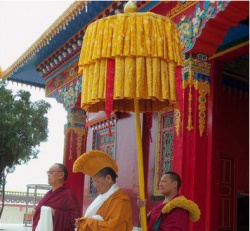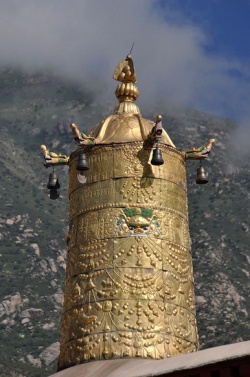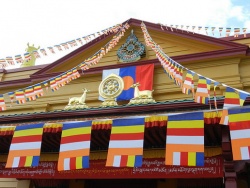Banner of victory
The dhvaja, meaning banner, flag or ensign, was originally a military standard of ancient Indian warfare. This standard adorned the rear of a great warrior's chariot and was mounted behind the great parasol (Skt. atapatra), or royal parasol (Skt. chatra). Each standard bore the specific sign of its champion or king. Krishna's chariot was adorned with a garuda topped banner. Arjuna's bore the emblem of a monkey. Bhisma's bore the emblem of a palm tree. But primarily the dhvaja was the ensign of Shiva, the great god of death and destruction, whose banner was topped with a trident. The trident symbolized Shiva's victory over the three worlds, which were located above, upon and below the earth.
In Indian warfare the military banner frequently took on horrific forms that were designed to instill terror in the enemy. Large effigies were also fashioned of other frightening creatures, such as the scorpion, snake, vulture, raven and garuda.
The crocodile headed banner or makara dhvaja was originally an emblem of Kamadeva, the vedic god of love and desire. As the "tempter" (Skt. mara) or "deluder (Skt. maya), Kamadeva was the Hindu counterpart of Mara, the "evil one", who attempted to obstruct the Buddha from attaining enlightenment. In early Buddhism the concept of Mara as a demonic obstructer to spiritual progress was presented as a group of four maras or "evil influences". These four maras were originally based upon the four divisions of Mara's army: infantry, cavalry, elephants and chariots. The first of these four maras is the demon of the five aggregates of the personality. The second is the demon of emotional defilements. The third is the demon of death. The fourth is the "son of the God Mara" or the demon of desire and temptation. It is this fourth mara, Devaputra-mara, who is identified as Kamadeva, the "king of the gods of the highest desire realm". The Buddha is said to have defeated the sensual temptations of Kamadeva in the dusk before his enlightenment by meditating upon the "four immeasurables" of compassion, love, sympathetic joy and equanimity. At dawn, Buddha overcame both the mara of the aggregates and the mara of the defilements. But it was only three months before the end of his long life that he finally overcame the mara of death through the power of his fearless resolve to enter into the ultimate nirvana (parinirvana).
As a symbol of the Buddha's victory over the four maras, the early Buddhist adopted Kamadeva's emblem of the crocodile headed makaradhvaja and four of these banners were erected in the cardinal directions surrounding the enlightenment stupa of the Tathagata or Buddha. Similarly the gods elected to place a banner of victory on the summit of Mt. Meru to honor the Buddha as the "Conqueror" (Skt. jina) who vanquished the armies of Mara.
Within the Tibetan tradition a list of eleven different forms of the victory banner is given to represent eleven specific methods for overcoming defilements. Many variations of the banner's design can be seen on monastery and temple roofs, where four banners are commonly placed at the roof's corners to symbolize the Buddha's victory over the four maras.
As a hand held ensign the victory banner is an attribute of many deities, particularly those associated with wealth and power, such as Vaishravana, the Great Guardian King of the North, Jambhala or Kubera and many others.
In Sanskrit, the banner or sign of victory is known as the dhvaja, meaning standard, flag or sign. Originally, the victory banner was a military standard carried in ancient Indian warfare, and bore the specific insignia of its champion. For example in the Mahabharata, Krishna's chariot was adorned with a banner showing the image of the monkey-god Hanuman. The victory banner was adopted by early Buddhism as an emblem of the Buddha's enlightenment, heralding the triumph of knowledge over ignorance. It is said to have been placed on the summit of Mt. Meru by Buddha himself, symbolizing his victory over the entire universe. Again, Mount Meru here is believed to be the central axis supporting the world.
The flag of victory also denotes Buddha's triumph over Mara, who personifies hindrances on the path to spiritual realization. Specifically, there are said to be four types of Maras, each one representing an individual hurdle on the path to spiritual progress. These are:
The Mara of Emotional Defilement
Mara of Passion
Mara of the Fear of Death
Mara of Pride and Lust
It was only after conquering these four negative traits that Buddha could proclaim victory over ignorance, and achieve nirvana.
Cylindrical victory banners made of beaten copper are traditionally placed at the four corners of monastery and temple roofs. These signify the Buddha's victorious dharma radiating to the four directions and also his triumph over the four Maras mentioned above.


